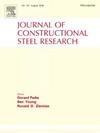Experimental and analytical investigation on the behavior of deformation-amplified torsional steel-tube dampers
IF 4
2区 工程技术
Q1 CONSTRUCTION & BUILDING TECHNOLOGY
引用次数: 0
Abstract
A novel torsional steel tube damper with deformation amplification function (DATSTD) to address the issue that traditional metallic dampers cannot sufficiently dissipate energy under small deformation was proposed. The basic structure and working mechanism of the DATSTD were described. A theoretical restoring force model was derived, together with an amplification formula for the deformation and load-bearing capacity of the DATSTD. The seismic performance of the DATSTD with varying initial amplification angles was investigated by low-cycle cyclic loading test, and the energy dissipation and failure mechanism of the DATSTD were studied. A robust finite element model for the DATSTD was developed using the ABAQUS software, and the effect of the rotating plate length on the mechanical properties of the DATSTD was studied in detail. The test results show that the hysteresis curve of the damper is smooth and full, exhibits certain asymmetric features, and maintains a stable and efficient energy dissipation capacity. By reducing the initial amplification angle, the plastic deformation of the energy-dissipation steel tube progresses more extensively, the equivalent viscous damping coefficient rapidly increases to approximately 50 %, and the yield load, maximum load, and initial stiffness of the damper all increase significantly. While the asymmetry of the hysteretic curve is also slightly enhanced. The theoretical restoring force model and the finite element model could predict the performance of the DATSTD well. With reduction of the rotating plate length, the influence of the initial amplification angle change on the energy dissipation and load-bearing capacity of the damper would be increased. The maximum tensile-to-compressive load ratio of the damper would be increased and the asymmetry of the hysteretic curve becomes more pronounced as decreasing of the of the rotating plate length.
变形放大扭转钢管阻尼器行为的实验和分析研究
针对传统金属阻尼器在小变形情况下无法充分消散能量的问题,提出了一种具有变形放大功能的新型扭转钢管阻尼器(DATSTD)。论文描述了 DATSTD 的基本结构和工作机理。推导出了恢复力理论模型,以及 DATSTD 变形和承载能力的放大公式。通过低周期循环加载试验研究了不同初始放大角 DATSTD 的抗震性能,并研究了 DATSTD 的能量耗散和破坏机理。利用 ABAQUS 软件为 DATSTD 建立了稳健的有限元模型,并详细研究了旋转板长度对 DATSTD 力学性能的影响。试验结果表明,阻尼器的滞后曲线平滑饱满,具有一定的非对称性,并保持了稳定高效的消能能力。通过减小初始放大角,消能钢管的塑性变形得到更广泛的发展,等效粘滞阻尼系数迅速增加到约 50%,阻尼器的屈服载荷、最大载荷和初始刚度都显著增加。滞回曲线的非对称性也略有增强。理论恢复力模型和有限元模型可以很好地预测 DATSTD 的性能。随着旋转板长度的减小,初始放大角的变化对阻尼器能量耗散和承载能力的影响将增大。阻尼器的最大拉压载荷比会增大,滞回曲线的不对称会随着旋转板长度的减小而变得更加明显。
本文章由计算机程序翻译,如有差异,请以英文原文为准。
求助全文
约1分钟内获得全文
求助全文
来源期刊

Journal of Constructional Steel Research
工程技术-工程:土木
CiteScore
7.90
自引率
19.50%
发文量
550
审稿时长
46 days
期刊介绍:
The Journal of Constructional Steel Research provides an international forum for the presentation and discussion of the latest developments in structural steel research and their applications. It is aimed not only at researchers but also at those likely to be most affected by research results, i.e. designers and fabricators. Original papers of a high standard dealing with all aspects of steel research including theoretical and experimental research on elements, assemblages, connection and material properties are considered for publication.
 求助内容:
求助内容: 应助结果提醒方式:
应助结果提醒方式:


